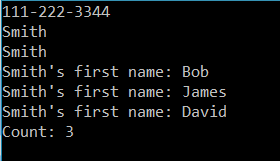LINQ, or Language Integrated Query, is a query language in the .NET Framework. LINQ is useful in that you could have several different data sources you are working with within Visual Studio, and LINQ provides a way to query data uniformly. Examples include SQL, Objects, ADO.NET, Entity Framework etc.
Here we will go through examples of using LINQ.
Firstly, to use LINQ, you add the namespace:
using System.Linq;
Let’s say we have a list of Customers:
Customer customer1 = new Customer();
customer1.FirstName = "Bob";
customer1.LastName = "Smith";
customer1.PhoneNumber = "111-222-3344";
Customer customer2 = new Customer();
customer2.FirstName = "James";
customer2.LastName = "Smith";
customer2.PhoneNumber = "111-222-3355";
Customer customer3 = new Customer();
customer3.FirstName = "David";
customer3.LastName = "Smith";
customer3.PhoneNumber = "111-222-3377";
List l = new List();
l.Add(customer1);
l.Add(customer2);
l.Add(customer3);
Using LINQ, we can easily find out several pieces of information, such as getting the phone number of a particular customer, returning a list of all customers that meet a certain condition, etc.
Lambda expressions are anonymous functions that are used to create delegates in LINQ. An example of a lambda expression is x => x == 1, where the => operator separates the variables from the body. In the code below, you can see how we can use Lambda expressions with LINQ to filter and retrieve information:
// Find Bob's phone number
string BobPhoneNumber = l.First(s => s.FirstName == "Bob").PhoneNumber;
Console.WriteLine(BobPhoneNumber);
// Return customer Bob
Customer Bob = l.First(s => s.FirstName == "Bob");
string BobLastName = Bob.LastName;
Console.WriteLine(BobLastName);
// Or using var
var David = l.First(s => s.FirstName == "David");
string DavidLastName = David.LastName;
Console.WriteLine(DavidLastName);
// Return all smiths
IEnumerable Smiths = l.Where(c => c.LastName == "Smith");
foreach (Customer Smith in Smiths)
{
Console.WriteLine("Smith's first name: {0}", Smith.FirstName);
}
// Return count
int count = (from customer in l
where customer.LastName == "Smith"
select customer).Count();
Console.WriteLine("Count: {0}", count);
This produces:

The main purpose of a Lambda expression is to simplify the amount of code written.
Consider our above example. Let’s say we wrote an anonymous method that returned the customers with a first name of “James”. It would look something like:
IEnumerable<Customer> James = l.Where(delegate (Customer c)
{
return c.FirstName == "James";
});
Which produces:

Or, we could write the lambda expression as more simply:
IEnumerable<Customer> James = l.Where(c => c.FirstName == "James");
I AM SPENDING MORE TIME THESE DAYS CREATING YOUTUBE VIDEOS TO HELP PEOPLE LEARN THE MICROSOFT POWER PLATFORM.
IF YOU WOULD LIKE TO SEE HOW I BUILD APPS, OR FIND SOMETHING USEFUL READING MY BLOG, I WOULD REALLY APPRECIATE YOU SUBSCRIBING TO MY YOUTUBE CHANNEL.
THANK YOU, AND LET'S KEEP LEARNING TOGETHER.
CARL



